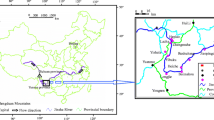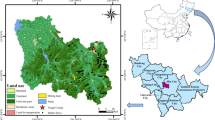Abstract
Susceptibility analysis is important in any study of debris flows. Unlike debris flows in Southwest China, debris flows in Northern China occur with different characteristics and much lower frequency. However, neglecting the danger of possible debris flows in this northern area may result in a devastating disaster. In this paper, 12 debris flow catchments located near Zhirui town, in Heshigten Banner, Inner Mongolia, China, were investigated. A geographic information system, a global positioning system, and remote sensing were used to determine geological, topographical, morphological, and vegetation factors of influence. Principal component analysis was carried out to convert this set of possibly correlated factors into a set of values of linearly uncorrelated principal components. The accumulative contribution rate of the first five principal components retained most of the information on these factors, accounting for 90.9 %. An improved fuzzy C-means clustering analysis was applied to determine the susceptibility of debris flows in this area. This method is based on a quantum-behaved particle swarm optimization algorithm, which is an evolutionary algorithm that can achieve global optimization, and is not sensitive to the initial cluster centers. Results showed that the susceptibility levels for four of the debris flow catchments were high, six were moderate, and two were low. Our quantitative assessments based on these nonlinear methods were consistent with field investigations.










Similar content being viewed by others
References
Avanzi GD, Giannecchini R, Puccinelli A (2004) The influence of the geological and geomorphological settings on shallow landslides. An example in a temperate climate environment: the June 19, 1996 event in north western Tuscany (Italy). Eng Geol 73:215–228
Bezdek JC (1981) Pattern recognition with fuzzy objective function algorithms. Plenum, New York
Bezdek JC, Ehrlich R, Full W (1984) FCM: the fuzzy C-means clustering algorithm. Comput Geosci 10(2–3):191–203
Carrara A, Crosta G, Frattini P (2008) Comparing models of debris-flow susceptibility in the alpine environment. Geomorphology 94:353–378
Crosta GB, Frattini P (2003) Distributed modelling of shallow landslides triggered by intense rainfall. Nat Hazard Earth Syst 3(1/2):81–93
de Scally FA, Owens IF, Louis J (2010) Controls on fan depositional processes in the schist ranges of the Southern Alps, New Zealand, and implications for debris-flow hazard assessment. Geomorphology 122(1–2):99–116
Dong JJ, Lee CT, Tung YH, Liu CN, Lin KP, Lee JF (2009) The role of the sediment budget in understanding debris flow susceptibility. Earth Surf Process Landform 34:1612–1624
Farzi S, Dastjerdi AB (2010) Leaf constrained minimal spanning trees solved by modified quantum-behaved particle swarm optimization. Artif Intell Rev 34(1):1–17
Giannecchini R, Naldini D, Avanzi GD, Puccinelli A (2007) Modelling of the initiation of rainfall induced debris flows in the Cardoso basin (Apuan Alps, Italy). Quat Int 171–172:108–117
Gokceoglu C, Tunusluoglu MC, Gorum T, Tur H, Gokasan E, Tekkeli AB, Batuk F, Alp H (2009) Description of dynamics of the Tuzla Landslide and its implications for further landslides in the northern slope and shelf of the Cinarcik Basin (Marmara Sea, Turkey). Eng Geol 106(3–4):133–153
Goktepe AB, Altun S, Sezer A (2005) Soil clustering by fuzzy C-means algorithm. Adv Eng Softw 36(10):691–698
Heisenberg W (1927) Über den anschaulichen Inhalt der quantentheoretischen kinematik und mechanik. Zeitschrift für Physik 43(3–4):172–198
Hu W, Xu Q, Rui C, Huang RQ, van Asch TWJ, Zhu X, Xu QQ (2015) An instrumented flume to investigate the initiation mechanism of the post-earthquake huge debris flow in the southwest of China. Bull Eng Geol Environ 74(2):393–404
Iverson RM (1997) The physics of debris flows. Rev Geophys 35:245–296
Jolliffe IT (2002) Principal component analysis, 2nd edn. Springer, New York
Kennedy J, Eberthart RC (1995) Particle swarm optimization. Proceedings of the IEEE international conference on neural networks. Perth, Australia, pp 1942–1948
Lee S, Chwae U, Min K (2002) Landslide susceptibility mapping by correlation between topography and geological structure: the Janghun area, Korea. Geomorphology 46:149–162
Li QM, Dehler SA (2015) Inverse spatial principal component analysis for geophysical survey data interpolation. J Appl Geophys 115:79–91
Li YY, Wang Q, Chen JP, Xu LM, Song SY (2015) K-means algorithm based on particle swarm optimization for identification of rock discontinuity sets. Rock Mech Rock Eng 48(1):375–385
Montgomery DR, Dietrich WE (1994) A physically based model for the topographic control on shallow landsliding. Water Resour Res 30:83–92
Ni HY, Zheng WM, Li ZL, Ba RJ (2010) Recent catastrophic debris flows in Luding county, SW China: geological hazards, rainfall analysis and dynamic characteristics. Nat Hazards 55(2):523–542
Niu CC, Wang Q, Chen JP, Wang K, Zhang W, Zhou FJ (2014) Debris-flow hazard assessment based on stepwise discriminant analysis and extension theory. Q J Eng Geol Hydrogeol 47:211–222. doi:10.1144/qjegh2013-038
Osna T, Sezer EA, Akgun A (2014) GeoFIS: an integrated tool for the assessment of landslide susceptibility. Comput Geosci UK 66:20–30. doi:10.1016/j.cageo.2013.12.016
Pal NR, Bezdek JC (1995) On cluster validity for the fuzzy C-means model. IEEE T Fuzzy Syst 3(3):370–379
Poli R, Kennedy J, Blackwell T (2007) Particle swarm optimization. Swarm Intell 1(1):33–57
Pradhan B, Sezer EA, Gokceoglu C, Buchroithner MF (2010) Landslide susceptibility mapping by neuro-fuzzy approach in a landslide prone area (Cameron Highland, Malaysia). IEEE Trans Geosci Remote Sens 48(12):4164–4177
Sezer EA, Pradhan B, Gokceoglu C (2011) Manifestation of an adaptive neuro-fuzzy model on landslide susceptibility mapping: Klang valley, Malaysia. Expert Syst Appl 38:8208–8219
Sezer EA, Nefeslioglu HA, Gokceoglu C (2014) An assessment on producing synthetic samples by fuzzy C-means for limited number of data in prediction models. Appl Soft Comput 24:126–134
Shen CW, Lo WC, Chen CY (2012) Evaluating susceptibility of debris flow hazard using multivariate statistical analysis in Hualien County. Disaster Adv 5:743–755
Sun J, Xu WB, Feng B (2004) A global search strategy of quantum-behaved particle swarm optimization. In: Cybernetics and intelligent systems proceedings of the 2004 IEEE conference, pp 111–116
Tian N, Lai CH (2014) Parallel quantum-behaved particle swarm optimization. Int J Mach Cyber 5(2):309–318
Wan S, Lei TC, Huang PC, Chou TY (2008) The knowledge rules of debris flow event: a case study for investigation Chen Yu Lan River, Taiwan. Eng Geol 98(3–4):102–114
Zhang W, Li HZ, Chen JP, Zhang C, Xu LM, Sang WF (2011) Comprehensive hazard assessment and protection of debris flows along Jinsha River close to the Wudongde dam site in China. Nat Hazard 58:459–477
Zhang W, Chen JP, Wang Q, An YK, Qian X, Xiang LJ, He LX (2013) Susceptibility analysis of large-scale debris flows based on combination weighting and extension methods. Nat Hazards 66(2):1073–1100
Zhang W, Chen JP, Wang Q, Yan JY, Guan S, Chen XY, Wang FF (2014) Velocity and runout determination of a debris flow based on energy conservation: the Dongwopu debris flow in Tianjin 48:5–14. Q J Eng Geol Hydrogeol, China. doi:10.1144/qjegh2014-036
Acknowledgments
This work was supported by the State Key Program of National Natural Science of China (Grant No. 41330636).
Author information
Authors and Affiliations
Corresponding author
Rights and permissions
About this article
Cite this article
Shi, M., Chen, J., Song, Y. et al. Assessing debris flow susceptibility in Heshigten Banner, Inner Mongolia, China, using principal component analysis and an improved fuzzy C-means algorithm. Bull Eng Geol Environ 75, 909–922 (2016). https://doi.org/10.1007/s10064-015-0784-z
Received:
Accepted:
Published:
Issue Date:
DOI: https://doi.org/10.1007/s10064-015-0784-z




